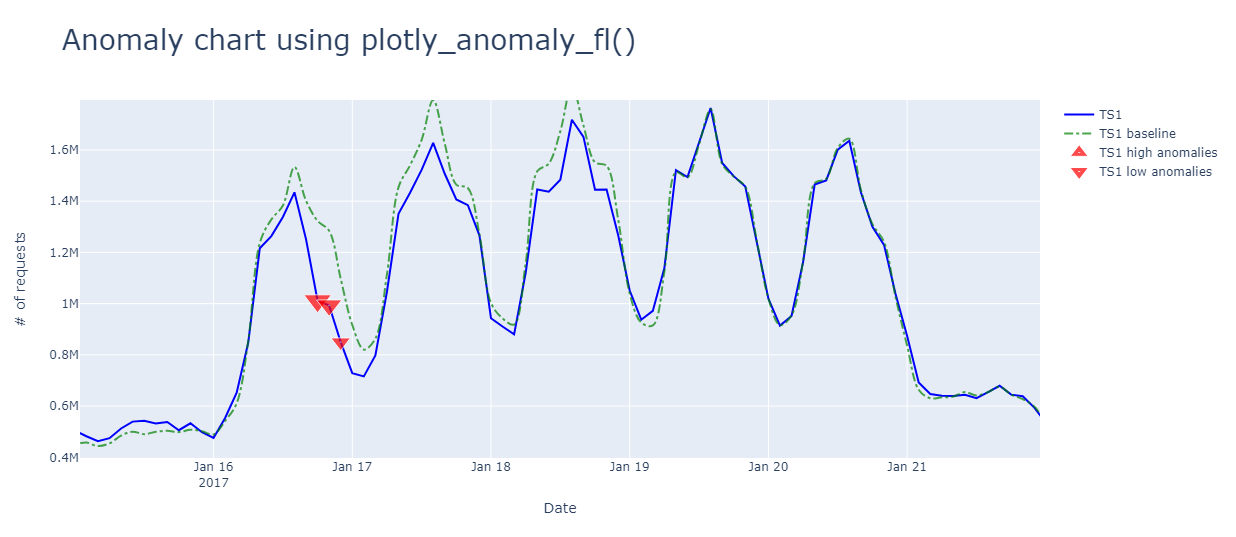函数 plotly_anomaly_fl() 是一个用户定义的函数 (UDF),可用来自定义 plotly 模板以创建交互式异常图。
该函数接受一个表,其中包含源和基线时序、积极和消极异常的列表及其相应大小,以及图表标记字符串。 该函数返回只有一个单元格的表,其中包含 plotly JSON。 (可选)可以在 Azure 数据资源管理器仪表板图块中呈现数据。 有关详细信息,请参阅 Plotly(预览版)。
注意
请考虑使用 Azure 数据资源管理器本机 " | render anomalychart" 方法来呈现非交互式异常图表。
先决条件
从公用的 PlotlyTemplate 表中提取所需的“anomaly”模板。 通过从目标数据库运行以下 KQL 命令,将此表从示例数据库复制到你的数据库:
.set PlotlyTemplate <| cluster('help.chinaeast2.kusto.chinacloudapi.cn').database('Samples').PlotlyTemplate
语法
T | invoke plotly_anomaly_fl(time_col, val_col, baseline_col, time_high_col, val_high_col, size_high_col, time_low_col, val_low__col, size_low_col, chart_title, series_name, val_name)
详细了解语法约定。
参数
| 客户 | 类型 | 必需 | 说明 |
|---|---|---|---|
| time_col | string |
✔️ | 包含原始时序时间点的动态数组的列的名称 |
| val_col | string |
✔️ | 包含原始时序值的列的名称 |
| baseline_col | string |
✔️ | 包含基线时序值的列的名称。 异常通常是根据与预期基线值的较大偏移来检测的。 |
| time_high_col | string |
✔️ | 包含高(高于基线)异常时间点的列的名称 |
| val_high_col | string |
✔️ | 包含高异常的列的名称 |
| size_high_col | string |
✔️ | 包含高异常标记大小的列的名称 |
| time_low_col | string |
✔️ | 包含低异常时间点的列的名称 |
| val_low_col | string |
✔️ | 包含低异常的列的名称 |
| size_low_col | string |
✔️ | 包含低异常标记大小的列的名称 |
| chart_title | string |
图表标题,默认值为“异常图表” | |
| series_name | string |
时序名称,默认值为“指标” | |
| val_name | string |
值轴名称,默认值为“值” |
函数定义
可以通过将函数的代码嵌入为查询定义的函数,或将其创建为数据库中的存储函数来定义函数,如下所示:
使用以下 let 语句定义函数。 不需要任何权限。
let plotly_anomaly_fl=(tbl:(*), time_col:string, val_col:string, baseline_col:string, time_high_col:string , val_high_col:string, size_high_col:string,
time_low_col:string, val_low_col:string, size_low_col:string,
chart_title:string='Anomaly chart', series_name:string='Metric', val_name:string='Value')
{
let anomaly_chart = toscalar(PlotlyTemplate | where name == "anomaly" | project plotly);
let tbl_ex = tbl | extend _timestamp = column_ifexists(time_col, datetime(null)), _values = column_ifexists(val_col, 0.0), _baseline = column_ifexists(baseline_col, 0.0),
_high_timestamp = column_ifexists(time_high_col, datetime(null)), _high_values = column_ifexists(val_high_col, 0.0), _high_size = column_ifexists(size_high_col, 1),
_low_timestamp = column_ifexists(time_low_col, datetime(null)), _low_values = column_ifexists(val_low_col, 0.0), _low_size = column_ifexists(size_low_col, 1);
tbl_ex
| extend plotly = anomaly_chart
| extend plotly=replace_string(plotly, '$TIME_STAMPS$', tostring(_timestamp))
| extend plotly=replace_string(plotly, '$SERIES_VALS$', tostring(_values))
| extend plotly=replace_string(plotly, '$BASELINE_VALS$', tostring(_baseline))
| extend plotly=replace_string(plotly, '$TIME_STAMPS_HIGH_ANOMALIES$', tostring(_high_timestamp))
| extend plotly=replace_string(plotly, '$HIGH_ANOMALIES_VALS$', tostring(_high_values))
| extend plotly=replace_string(plotly, '$HIGH_ANOMALIES_MARKER_SIZE$', tostring(_high_size))
| extend plotly=replace_string(plotly, '$TIME_STAMPS_LOW_ANOMALIES$', tostring(_low_timestamp))
| extend plotly=replace_string(plotly, '$LOW_ANOMALIES_VALS$', tostring(_low_values))
| extend plotly=replace_string(plotly, '$LOW_ANOMALIES_MARKER_SIZE$', tostring(_low_size))
| extend plotly=replace_string(plotly, '$TITLE$', chart_title)
| extend plotly=replace_string(plotly, '$SERIES_NAME$', series_name)
| extend plotly=replace_string(plotly, '$Y_NAME$', val_name)
| project plotly
};
// Write your query to use the function here.
示例
以下示例使用 invoke 运算符运行函数。
若要使用查询定义的函数,请在嵌入的函数定义后调用它。
let plotly_anomaly_fl=(tbl:(*), time_col:string, val_col:string, baseline_col:string, time_high_col:string , val_high_col:string, size_high_col:string,
time_low_col:string, val_low_col:string, size_low_col:string,
chart_title:string='Anomaly chart', series_name:string='Metric', val_name:string='Value')
{
let anomaly_chart = toscalar(PlotlyTemplate | where name == "anomaly" | project plotly);
let tbl_ex = tbl | extend _timestamp = column_ifexists(time_col, datetime(null)), _values = column_ifexists(val_col, 0.0), _baseline = column_ifexists(baseline_col, 0.0),
_high_timestamp = column_ifexists(time_high_col, datetime(null)), _high_values = column_ifexists(val_high_col, 0.0), _high_size = column_ifexists(size_high_col, 1),
_low_timestamp = column_ifexists(time_low_col, datetime(null)), _low_values = column_ifexists(val_low_col, 0.0), _low_size = column_ifexists(size_low_col, 1);
tbl_ex
| extend plotly = anomaly_chart
| extend plotly=replace_string(plotly, '$TIME_STAMPS$', tostring(_timestamp))
| extend plotly=replace_string(plotly, '$SERIES_VALS$', tostring(_values))
| extend plotly=replace_string(plotly, '$BASELINE_VALS$', tostring(_baseline))
| extend plotly=replace_string(plotly, '$TIME_STAMPS_HIGH_ANOMALIES$', tostring(_high_timestamp))
| extend plotly=replace_string(plotly, '$HIGH_ANOMALIES_VALS$', tostring(_high_values))
| extend plotly=replace_string(plotly, '$HIGH_ANOMALIES_MARKER_SIZE$', tostring(_high_size))
| extend plotly=replace_string(plotly, '$TIME_STAMPS_LOW_ANOMALIES$', tostring(_low_timestamp))
| extend plotly=replace_string(plotly, '$LOW_ANOMALIES_VALS$', tostring(_low_values))
| extend plotly=replace_string(plotly, '$LOW_ANOMALIES_MARKER_SIZE$', tostring(_low_size))
| extend plotly=replace_string(plotly, '$TITLE$', chart_title)
| extend plotly=replace_string(plotly, '$SERIES_NAME$', series_name)
| extend plotly=replace_string(plotly, '$Y_NAME$', val_name)
| project plotly
};
let min_t = datetime(2017-01-05);
let max_t = datetime(2017-02-03 22:00);
let dt = 2h;
let marker_scale = 8;
let s_name = 'TS1';
demo_make_series2
| make-series num=avg(num) on TimeStamp from min_t to max_t step dt by sid
| where sid == s_name
| extend (anomalies, score, baseline) = series_decompose_anomalies(num, 1.5, -1, 'linefit')
| mv-apply num1=num to typeof(double), anomalies1=anomalies to typeof(double), score1=score to typeof(double), TimeStamp1=TimeStamp to typeof(datetime) on (
summarize pAnomalies=make_list_if(num1, anomalies1 > 0), pTimeStamp=make_list_if(TimeStamp1, anomalies1 > 0), pSize=make_list_if(toint(score1*marker_scale), anomalies1 > 0),
nAnomalies=make_list_if(num1, anomalies1 < 0), nTimeStamp=make_list_if(TimeStamp1, anomalies1 < 0), nSize=make_list_if(toint(-score1*marker_scale), anomalies1 < 0)
)
| invoke plotly_anomaly_fl('TimeStamp', 'num', 'baseline', 'pTimeStamp', 'pAnomalies', 'pSize', 'nTimeStamp', 'nAnomalies', 'nSize',
chart_title='Anomaly chart using plotly_anomaly_fl()', series_name=s_name, val_name='# of requests')
| render plotly
输出
输出是一个 Plotly JSON 字符串,它可以使用“| render plotly”或在 Azure 数据资源管理器仪表板磁贴中进行呈现。 有关创建仪表板磁贴的详细信息,请参阅使用 Azure 数据资源管理器仪表板直观显示数据。
下图显示了在使用上述函数后显示的异常图表示例:

可以放大并将鼠标悬停在异常上:

